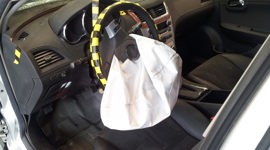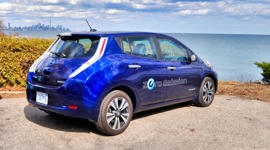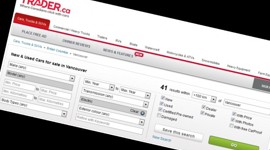The trending buzzword in headlines these days is “electrification”. Starting with California in 1998, governments took it upon themselves to pry us away from our fossil fuel vehicles. The Sunshine State’s intentions were good, but it turns out you can’t legislate scientific progress – these things take time. The infamous “zero emissions” mandate targeted vehicle manufacturers, as if they were hiding electric vehicle (EV) knowledge in a secret vault.
Time heals most wounds, and after a few legal sputters, available technology finally caught up with the zero emissions mantra. Manufacturers like GM and BMW first tested the waters with EVs leased to the general public as part of the development process, while in parallel, a cottage industry of tinkerers marketed EV conversions to green enthusiasts.
Finally, in 2011 Nissan released the Leaf, the first ground-up EV offered by a mass-market manufacturer. As the Leaf, iMiEV and Volt came to market, early adopters rushed to dealerships with “green” dollars in hand to be among the first to cut ties with Big Oil. Now that EV technology is mature enough for the general public, and has attained rock star status on social media thanks to the “Tesla Effect”, governments are strengthening emissions standards to support the sale of zero-emissions vehicles, and in return manufacturers are investing billions developing EVs for various market segments. The irony now is that vehicle manufacturers are the ones putting the pressure on governments, as they seek a return on massive EV investments. The question they’re asking is: where are those buyers you promised us?
From early adopters to general acceptance

EVs are a lot like halo sport cars. During their development process, a blossoming buzz of excitement rises in a crescendo that peaks just as dealers start accepting deposits. Once the chain of supply is fed, sales take off, breaking records in the first months. And then, with early buyers enjoying their coveted prize, demand is satisfied and sales take a dive off the cliff – time to put incentives under the hood. EVs spoke loudly to passionate individuals, the Early Adopters, and only a portion of them actually had the means to purchase an EV. And once they did, the market for EVs tapered off rapidly. In 2014, plug-in vehicles had a market share of 0.27% in Canada. A year later, that share had barely risen to 0.35% despite new offerings. Sales of BMW’s i division dropped 23% in the first quarter of 2016, and in the USA plug-in sales plummeted, thanks to fuel prices that hover at half of what we pay here in Canada. Conspiracy theorists can drop the arguments now – the product is here, good and plentiful. Surveys indicated the average motorist loves the idea of an electric car – considered clean and cheap to run – and 33% of Canadian commuters would consider going electric. What went wrong?
The average Canadian drives 15,200 km per year, and 4 times out of 5 will commute to work by private car, the median return trip being 34 km. These statistics are well within the range of mass-market EVs currently available for sale. So why do we all have cold feet when it comes time to sign on the dotted line? Well, for one thing, we don’t like having cold feet, and “them electric thingamabobs run out of juice when supplying heat.” There’s also the classic “How do you unplug that thing during an ice storm?” and, of course, let’s not forget, “It’ll take two days to complete a four-hour drive”. The general public is used to the safety blanket of a five-minute fill-up providing 500 km of range, and to relax in a toasty cabin during Great White North winters. EVs bring the general public out of that comfort zone, myths gain traction and none of the charts, anti-oil and electro-technical discourse put out by left-leaning EV enthusiasts and lobby groups do anything to reassure the Timmy-sipping masses. The main challenge EVs face is acceptance by regular folks like you and me, beyond the Early Adopters. The product is here, but how can the industry push it through the glass ceiling that separates the EV world from the mainstream?
Friends in high places

One thing is very clear: the government wants YOU to buy an electric car. It doesn’t matter where you live, some form of direct or indirect subsidies are being put in place to steer the public from its entrenched internal combustion habits. In the Netherlands, where EVs already enjoy a 9.6% market share, the government is considering legislation that will ban the sale of fossil fuel vehicles from 2025 onwards. Norway, rich thanks to oil production (of all things) has pushed an unmatched set of incentives and benefits towards EV drivers, and has set the world of EV fans on fire with a market share of 22%.
In Canada, three provinces offer direct incentives to car shoppers towards the purchase of an electric vehicle: Ontario ($9,600), Quebec ($8,000) and British Columbia ($5,000). All amounts apply to the final purchase price after taxes. The goal of these incentives is to lower a cost of entry that is kept high by the relatively small sales volume of vehicles that are costly for manufacturers to develop and build. These incentives have recently gained credibility with the addition of a price cut-off point, as subsidising the purchase of six-figure Teslas created uproar with taxpayers.
The same provinces will also help you purchase a charging station for your home and upgrade your power supply to support at-home charging. Even if you’re not living in the “Green Three”, indirect subsidies are there to support the EV market, whether you’re talking about infrastructure research or deploying charging facilities. Over the next two years, the Trudeau government will spend $62.5M to support the deployment of alternate-fuel charging/fill-up infrastructure in the country. Shades of California are appearing in Quebec, though. The Couillard government is still aiming for 100,000 EV registrations in La Belle Province by 2020, and showed rampant optimism by adding another target: 300,000 EVs by 2026, no less. Let’s recall here that only 8,500 EVs are registered in Quebec as of writing, and you can sense that something drastic will have to take place over the next four years for the government to save face. Quebec ministers, fresh from an official visit in California, came back with a strong intent of forcing a zero-emissions law upon manufacturers to “solve” the problem. However, it seems clear that consumer resistance is responsible here for the poor market penetration – demand is simply not following in supply’s footstep.
How to get you to consider an EV

So we have established that the general public shows some resistance to the “move”, but that elements are in place to help make the electric medicine go down. While our governments tackle the issue of how to get you to consider an EV, let’s go back to the title of this feature and consider the question: Is an EV right for me? To help you find the answer, your author parked his diesel commuter, trading its bladder-busting range for the silent running of various plug-in machines. Living in a detached single-family home located in suburbia and driving 25 km to a downtown job surrounded by the commuting masses, I am prime target for EV conversion, probably like you, dear reader. Furthermore, although I recycle stuff, I don’t hug my trees, nor do I sneer at internal combustion cars or blog against use of fossil fuels. I’m just a regular guy, and through my non-partisan EV immersion I will take you through a few questions to see if electric motoring fits your lifestyle.
How much driving do you do – really?

Driving an EV means being able to live with the range of a gas car whose low-fuel light is turned on. That’s the cold, hard truth for most affordable EVs. Still, with a two-way commute of 50 km, I’m only using 50% of the overall capacity of the battery, leaving room for a few detours along the way. The first time I sat in my BMW i3 loaner, range anxiety, that wicked stepmother of EV drivers, was right there in the passenger seat. I needed to drive at least 55 km on that day before topping up, and the battery gauge indicated 76 km. Ruh-roh. I quickly learned how elastic range can be; thanks to mid-day traffic, I kept speeds in check on the drive to work, every coasting opportunity or brake application enabling the car to regenerate some electricity all by itself while I kept my eyes on the road. 25 km later, my indicated range was … 76 km. EVs love low speeds and “slinky” traffic motions where you don’t quite stop. Sustained high speeds will eat more range than the actual driven distance, but on average I found that I could trust the range that was indicated. After a week each with a BMW i3 and a Ford Focus Electric, I came up with a rule of thumb: if your daily driven distance is half the EV’s range, you’re well within the comfort zone for electric motoring, with room for a few impromptu errands.
Will I freeze to death?

Short answer: no. Heating up the cabin does eat up a lot of electrons, though. On a cold 3°C April morning, my fully-charged Focus Electric indicated a max range of 125 km, besting Ford’s claim by a bit. Sitting still in my driveway, just the act of turning on the climate control instantly removed 30 km of estimated range. The Focus is a refreshingly analog EV, being at core a regular car converted to EV status. As such, it only offers two driving modes through a regular gearshift lever, “D” or “L”, with the latter increasing regeneration while coasting by simulating a lower gear. Toggling between the two has no effect on the indicated range. The high-tech BMW i3’s 130 km max range is only available in the “Eco Pro +” mode, turning off HVAC altogether (ambient air only), along with capping your top speed at 90 km/h. With snow on the ground and frost in the air, needless to say I left the car in “Eco Pro” mode most of the time, enabling a power-optimized HVAC operation and a more practical 130 km/h max speed. Max range in this mode is 110 km. The final mode behind the i3’s buttons is “Comfort”, granting full HVAC power, no speed governor and a max range of only 100 km. Even though these two EVs are as radically different as they could be, getting the cabin toasty warm in both of them will cost you 30 km of range – keep that in mind when looking at promised EV range in product literature. Most EVs have the capacity to heat up the interior while plugged-in, a pre-conditioning that reduces the heavy lifting for the HVAC system while the car is on the move. The other range-saving trick is to use the power-efficient seat heaters instead of HVAC when conditions don’t call for defrosting the windows.
Do I have to adapt my driving style?

Yes. The old adage “You have to pay to play” comes to mind here. Driving with traffic and not exceeding the speed limits by much will yield you a 1:1 range / distance ratio, a 25 km drive resulting in a 25 km drop of indicated range, HVAC or no. However, reverting to my usual highway ramp and passing lane shenanigans while enjoying a climate-controlled 23°C cabin and rockin’ the tunes cost me 40 to 45 km of range over the same 25 km commute in both the i3 and the Focus. The BMW’s terrific power-to-weight ratio proved highly tempting to take advantage of, with repeated short blasts of that fantastic torque surge (0-60 mph in 6.5s according to Car and Driver, to the Focus EV’s 9.9). It’s a lethal point-and-shoot tool to carve traffic with, but range will suffer. The Focus is no slouch either – passing performance at highway speeds is impressive thanks to the direct drive “transmission”. In the end, EVs are a lot like turbocharged cars – use the power, pay the price.
Can I really charge at home?

Yes. All you need is a regular 110V household plug on a 15 amp circuit (20 even better), and you’re good to go. In the case of my own 50 km daily commute, having 110V at home and at work meant that I started every trip on a full battery, both with the i3 and the Focus. If you only charge at home though, mind your battery use as both of these EVs require 20 hours to fully charge on a regular household outlet. Another important point to consider: you can’t use an extension cord. Manufacturers provide a fairly long cable with their domestic charging device, but having a plug near your parking space is a must as extension cords are prohibited. If buying or leasing an EV, investing in a 220V home charging station is definitely worth considering. Government subsidies exist in certain provinces for purchase and installation of the device provided said installation is completed by a professional electrician. If you’re considering 220V charging, do consult with your electrician to see if your panel is up to the task. Most newer homes have that capacity, and in Quebec the government is about to introduce a bill to make EV charging a standard feature for all new homes.
What about these public charging stations?

Don’t be shy, you can use them, but most aren’t free. Right now, the majority of charging stations are of the 220V type, similar to what you can install at home. Their aim is to alleviate range anxiety on longer journeys, to facilitate the use of EVs in car-sharing schemes and to enable city dwellers to charge up if they can’t do so at their apartment building. These facilities are managed by operators such as Le Circuit Electrique (Quebec and Eastern Ontario), Sun Country Highway or ChargePoint, amongst others. To unlock charging, you need an RFID membership card linked to an account; a typical charge runs $2.50, independent of time plugged-in. On top of that, they are often located in paid-parking garages. A certain Swedish furniture store does offer free charging while you shop, as do other businesses. In Montreal, a charging station is considered a “busy location” if it’s used twice daily.
Remember that a full charge often takes four hours, and that more often than not EV drivers charge up at home and at work. The easiest way to find charging stations and check rates & availability is by using the free PlugShare app on your data-enabled smartphone, or visiting its website. I never had an issue with charging station availability, finding them unoccupied most of the time; I used them on a few occasions just to study how they work. I had set up a Circuit Electrique account beforehand, which sent me an automatic email after every charge with detailed data of the transaction (time, charging rate, electricity transferred to the car). Neat!
Quick charge – how does that work?

The famous “80% charge in 30 minutes” you hear about applies to DC quick charging, of which only 130 facilities exist in Canada as of this writing (there are more than 3,400 public charging facilities overall in Canada, all types combined). These bulky devices use high voltage, 400+ volts, beyond the capacity of residential power supplies. Their size comes from the fact that the charge is managed by the device, not the car, and also because of the required cooling system due to the heat generated by the high voltage. Why so few? Dueling standards meant cautious deployment. All EVs use a standard SAE plug for 120 or 220V charging, but for DC there are three non-compatible standards: CHAdeMO (Asian car manufacturers), SAE CCS Combo (American and European car manufacturers) and Tesla’s brand-exclusive Supercharger. Not all EVs are DC-enabled, and even then the feature is often found on the options list. DC quick-charge is a must if you’re planning highway travel with an EV, and if that is the case, study the available charging infrastructure on your favourite routes and check that they are compatible with the EV you’re considering. For the record, the i3 loaner had DC capacity, but I never needed it. The current Focus EV doesn’t have it, but will get it for 2017. Typically, a 30-minute DC charge will cost you twice what is charged for a time-unlimited 220V charge, but that may vary depending on who operates the facility.
Will I need a physics degree to understand all of this?

No, an EV is just a car, not a science fair project. Plug, unplug, get in and drive. Driving an EV doesn’t come with a pre-requisite to blog about your power use, to analyze the life cycle of your battery and to plot graphs showing how much the ozone layer benefits from your sustainable choices. Just mind your battery level as you would your fuel gauge and enjoy your silent running. Modern EVs drive just as naturally as any other car, no special training is required other than adjusting to the car’s sensitive regeneration, usually through the brake pedal.
Money-wise, does an EV make sense for me?

If you live in one of the Green Three provinces, yes. Otherwise, as a general rule, no.
We covered the math in detail when we looked at the value of alternative fuel types.
Your situation may offer specific pro-EV considerations though. In Quebec and Ontario, EVs are granted special “green” licence plates, giving you a free pass on most tolled bridges and unrestricted access to HOV lanes, when indicated. In BC, just like in California, a sticker is issued to drivers of plug-in vehicles to allow them to drive in HOV lanes, even with no passengers on board. You may even find “VIP” parking spots, and sometimes they’ll even be free, with charging included. These savings add up, both in time and money!
Final words

These days, there are a lot of public announcements for increased deployment of charging stations, and mayors love ribbon-cutting opportunities when facilities are inaugurated. However, this public infrastructure model won’t be able to sustain a sharp increase in EV sales. Just look around you – if all these cars need plugging in, all at once, it makes absolutely no sense to supply a plug to everything on wheels. When mass EV adoption is achieved, let’s hope charging times are drastically reduced and that the private sector will be there and ready (Electro Canada anyone?). Early Adopters may wish for one spot = one plug, but that’s a lot of juice to spread around, folks, especially at the curb. Free tolls and car pool lane access probably won’t last either once a certain market share is reached, so now is the time to benefit from the perks of EV driving. Even better, there’s an upcoming crop of 2017 EVs with extended ranges that will make the deal even sweeter, kicking range anxiety to the curb once and for all. Is an EV right for me? If you’re living in the Green Three, consider this answer: Yes.







